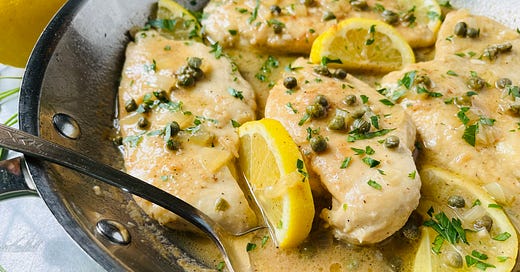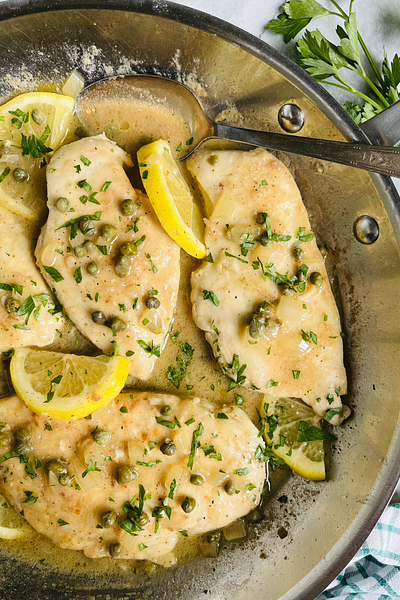Chicken Piccata
This classic chicken piccata recipe features a light, bright, and flavorful lemony sauce with briny capers. Served with pasta and a simple tossed salad, it’s a perfect springtime dish.
If you love making quick skillet dinners, you have to try this chicken piccata recipe. Ready in about 30 minutes, lean boneless, skinless chicken breasts are dredged in a mix of flour and parmesan cheese and pan-sautéed. The tangy skillet sauce that coats the chicken is made with white wine, chicken broth, fresh lemon juice, and capers. Garnished with lemon slices and freshly minced parsley, this chicken piccata is fancy enough for company or simple enough for a weeknight dinner with the family.
To speed up the cooking process, use boneless, skinless chicken breasts that are no more than a 1/2 inch thick. Some recipes suggest pounding the chicken breast to create a thinner cutlet. I skip the pounding technique and simply cut the breast in half horizontally, making two, perfectly sized chicken breasts. Slicing two large (8 to 10 ounces each) chicken breasts in half will yield four thinner breasts weighing 4 to 5 ounces each. That’s the perfect size for this recipe.
Purchasing boneless skinless breasts, or any type of poultry for that matter, can be a bit confusing these days. Terms like “free range,” “fresh poultry,” and “no hormones” are often plastered on poultry packaging. The USDA's Food Safety and Inspection Service (FSIS) is the agency responsible for ensuring accuracy in labeling poultry and meat. They’ve compiled a glossary of poultry labeling terms that can help with the decision-making process.
Fresh Poultry
“Fresh” means whole poultry and cuts have never been below 26 degrees F, the temperature at which poultry freezes. Fresh poultry should always bear a “keep refrigerated” statement.
Natural
A product containing no artificial ingredients or added color and is only minimally processed can be labeled “natural.” Minimal processing does not fundamentally change the raw product (i.e., removing the skin from chicken breast). The label must explain the use of the term natural, such as “no added color,” “no artificial ingredients,” or “minimally processed.”
Organic
Organic poultry must meet the standards set by the USDA’s National Organic Program. Some standards include that organic poultry must be naturally raised (drugs and antibiotics are prohibited) and have outdoor access. Their feed must also be certified organic.
Free Range or Free Roaming
Producers must demonstrate that the poultry has been allowed access to the outdoors.
No Hormones
Hormones are not allowed in raising poultry. The claim "no hormones added" cannot be used on poultry labels unless followed by a statement that says, "Federal regulations prohibit the use of hormones."
No Antibiotics (antibiotic free)
The claim “no antibiotics added" may be used on labels for poultry products if documentation is provided to the FSIS demonstrating that the animals were raised without antibiotics.
To your health,
Darlene
Follow Recipes Made Healthy on Instagram
CHICKEN PICCATA
Yield: 4 servings
Serving Size: 1 chicken breast with sauce
Prep: 15 minutes
Ready: 30 minutes
INGREDIENTS
1/4 cup all-purpose flour
2 tablespoons grated parmesan cheese
3/8 teaspoon kosher salt, divided
3/8 teaspoon black pepper, divided
4 (4 to 5 ounces each) raw boneless, skinless chicken breasts
4 tablespoons spreadable butter and oil blend (such as Challenge Spreadable Butter), divided
1/4 cup finely diced onion
1/2 cup reduced-sodium chicken broth
1/2 cup dry white wine (such as sauvignon blanc, pinot grigio, or chardonnay)
3 tablespoons fresh-squeezed lemon juice
2 tablespoons drained capers
1 lemon, cut into slices
3 tablespoons minced fresh parsley
DIRECTIONS
In a shallow dish, combine flour, parmesan cheese, 1/8 teaspoon salt, and 1/8 teaspoon black pepper. Lightly dredge chicken breasts in seasoned flour mixture.
Working in batches, in a large skillet over medium heat, melt 1 tablespoon spreadable butter. Add 2 breaded chicken breasts and sauté until lightly brown; about 3 to 4 minutes on each side. Remove chicken from skillet, place on a plate, and cover. Add another tablespoon of spreadable butter to skillet and cook remaining 2 chicken breasts (3 to 4 minutes on each side). Remove chicken breasts from skillet and add to plate.
Add remaining 2 tablespoons of spreadable butter to skillet along with onion and sauté for 1 minute. To skillet, add chicken broth, wine, lemon juice, capers, and remaining 1/4 teaspoon salt and 1/4 teaspoon black pepper. Stir to combine, loosening any brown bits on bottom of skillet. Add chicken breasts to skillet and allow sauce to lightly simmer and thicken slightly; about 2 to 3 minutes. Ensure that chicken breasts have reached an internal temperature of 165 degrees F before serving. Garnish with lemon slices and parsley and serve.
Nutrition Information per Serving
360 Calories, 15 g Total fat, 5 g Saturated fat, 0 g Trans fat, 113 mg Cholesterol, 496 mg Sodium, 12 g Total carbohydrate, 1 g Dietary fiber, 2 g Total sugars, 0 g Added sugars, 37 g Protein, 0 mcg (0%) Vitamin D, 65 mg (6%) Calcium, 2 mg (10%) Iron, 379 mg (8%) Potassium
© 2024 RECIPES MADE HEALTHY BY DARLENE ZIMMERMAN, MS, RD LLC







Such a good springtime recipe. Glad you liked it Sheryl!
Awww, thanks Sheryl!!!